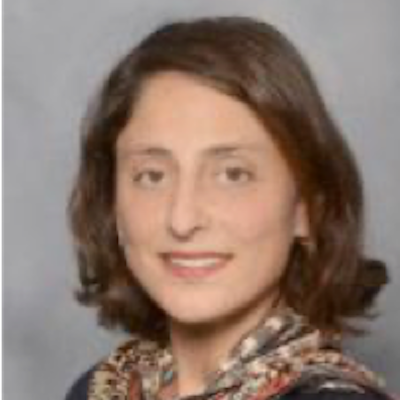Part V: The Global North (North America and Europe)
Chapter 15: The Global North: Introducing the Region
Lara Braff and Katie Nelson
What is the Global North? The Global North does not refer to a geographic region in any traditional sense but rather to the relative power and wealth of countries in distinct parts of the world (figure 15.1). The chapters in this section explore the construction and complexity of gender within the Global North: particularly, the United States, Canada, and Belgium. To do so, we first consider how the Global North and South divide came to exist in the popular imagination. However, we should note that although the Global North is on the whole powerful and wealthy, it is not monolithic. Societies within it are internally stratified and diverse such that not everyone in the Global North is rich and powerful.
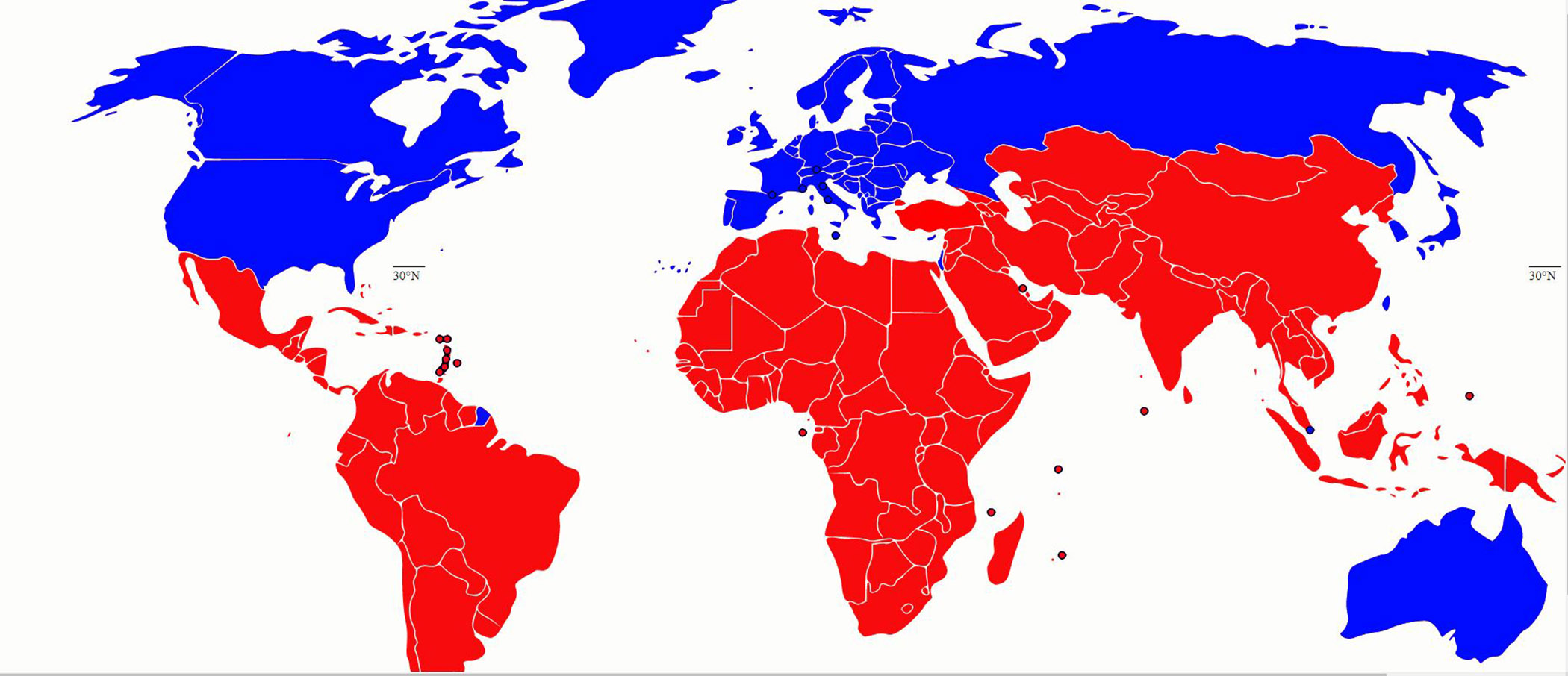
Attempts to categorize the world order have been based more on politics and economics than geography. These include East and West; developed and developing nations; and the First, Second, and Third Worlds. For example, if East/West were geographic entities, then all nations west of the Prime Meridian (i.e., the United States, Canada, and Latin America nations) would be grouped together, while all nations to the east (i.e., countries of Europe, Africa, and Asia) would be grouped together. But this is not the case. Rather, the “West” is meant to refer to countries—particularly European nations and the United States—that benefited from the exploits of colonialism, achieving a higher quality of life and more power than the East. Similarly, the terminology of “developed” and “developing” nations indexes a power differential along with the ethnocentric assumption that all countries follow a singular idealized trajectory. Anthropologists and social theorists have critiqued this notion, insisting that societies change over time, proceeding along varied developmental paths.
The First, Second, and Third World terminology developed in the mid-twentieth century during the Cold War to categorize nations based on their participation in the conflict between the democratic United States (and its allies) and the Communist Soviet Union (and its allies). The First World was said to include economically developed, high-income, politically stable capitalist nations. The Second World comprised Communist nations that despite stable incomes and decent social conditions were viewed by the First World as economically and politically unstable due to their totalitarian governments. The Third World referred to previously colonized nations (nonaligned) that both the United States and the Soviet Union were trying to incorporate into their respective political-economic orders. Third World leaders have critiqued this schema, asserting that they were not just pawns in the US-Soviet conflict; rather, they were actively engaged in improving their own social conditions, creating stable national identities, and participating in the global community (e.g., in the 1960s, some Third World countries joined the United Nations for the first time).
In the late twentieth century, the Global North and South terminology replaced previous descriptors of the global order. It was generally agreed that the Global North would include the United States, Canada, England, nations of the European Union, as well as Singapore, Japan, South Korea, and even some countries in the southern hemisphere: Australia, and New Zealand. The Global South, on the other hand, would include formerly colonized countries in Africa and Latin America, as well as the Middle East, Brazil, India, and parts of Asia. Many of these countries are still marked by the social, cultural, and economic repercussions of colonialism, even after achieving national independence. The Global South remains home to the majority of the world’s population, but that population is relatively young and resource-poor, living in economically dependent nations.
Like prior attempts to characterize nations, the Global North/South distinction simplifies the world order, ignoring internal variation within both the North and South, while negating commonalities that exist between these large and diverse entities. Further, there are outliers that muddy the attempt to specify a clear North/South divide. For example, where do China, Russia, and Saudi Arabia fit? In terms of their economies and power, they resemble the North, but their political and social organization can also resemble the South. All global terminology systems discussed here are historically situated, politicized attempts to organize nations into a straightforward world order that is, in fact, quite complicated and increasingly interconnected.
The World Economy
A rapidly globalized economy has highlighted the imagined divide between the North and South. According to Wallerstein’s world systems theory, a global capitalist system separates countries into the core (the North), semiperiphery, and periphery (the South) based primarily on their economic participation (Wallerstein 1974). His theory is largely influenced by Karl Marx, who saw the economy as the foundation of society that determined all cultural phenomena. According to Marx, under capitalism, societies are composed of the bourgeoisie (the owners who control the means of production, e.g., the factories) and the workers (who labor and produce goods in exchange for wages). The owner’s motive to maximize profit is achieved by exploiting the workers, who are paid less than what their labor is worth and who grow alienated from themselves, other people, and their labor. Despite the ideological attempts of the owners to obscure exploitation, Marx believed that the workers would eventually realize the systemic injustices of capitalism, rise up, and replace it with Communism.
For Wallerstein, similar actors and structural inequalities operate within the global capitalist system. The core nations of the Global North act like the owners, controlling multinational corporations that extract raw material and exploit labor from peripheral nations of the Global South. The core nations thereby amass profit that benefits them, hardening the divide between the haves and have-nots. Thus, core nations remain wealthy, politically stable, and culturally dominant, while peripheral nations remain economically dependent, politically unstable, and at the mercy of cultural trends. The semiperipheral nations are said to be in transition from the periphery to the core (see figure 15.2).
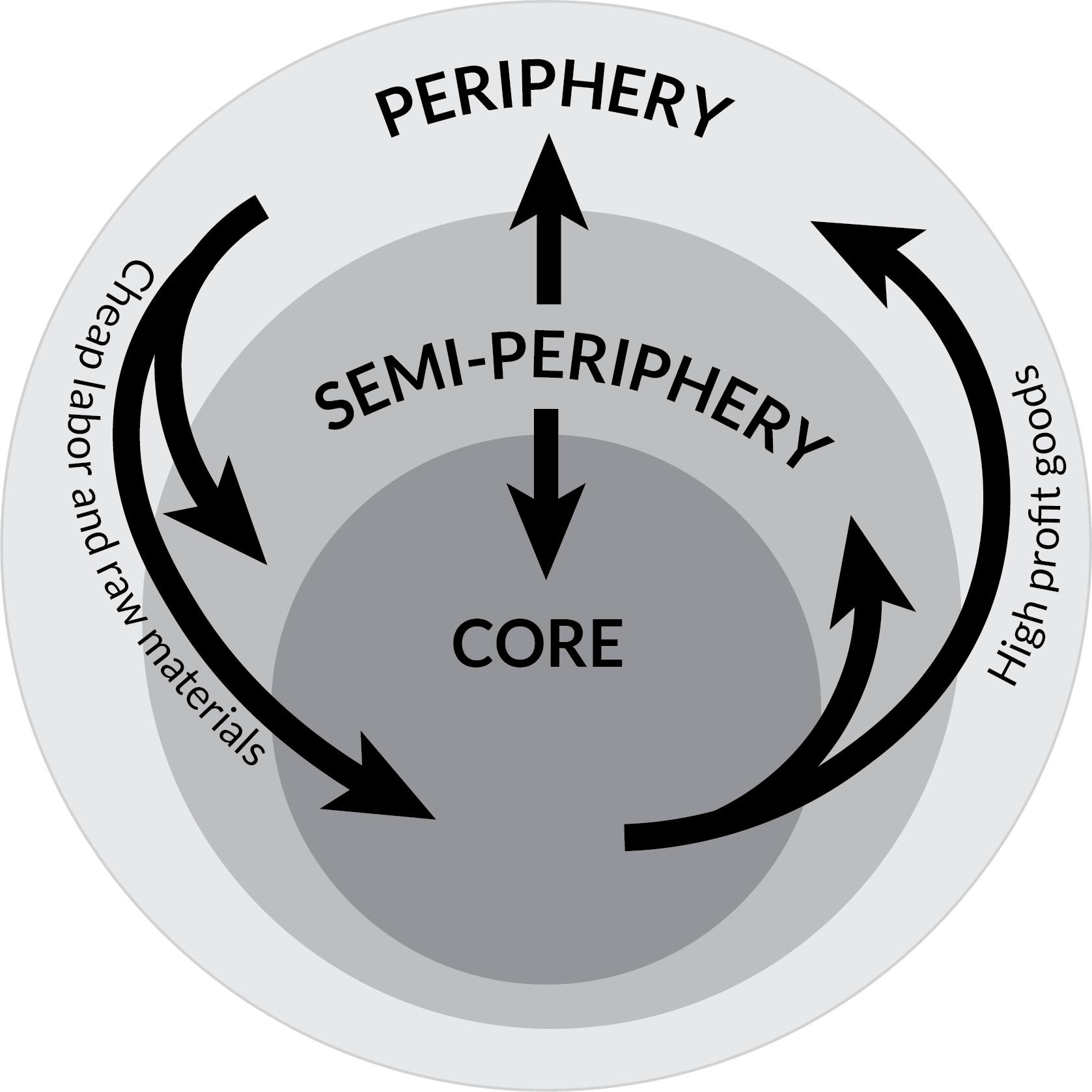
Like all binaries, the division of the world into core and periphery, North and South, is overly simplistic and assumes these are fundamentally different and unequal entities. Yet, we are not a world indelibly marked as wealthy or poor, producers or consumers, powerful or powerless. For many anthropologists, the world order is far more complex and interrelated. They consider, for example, the process of glocalization, whereby people around the world alter globalized goods, ideas, and practices to fit their own lived experiences. This is not the passive, wholesale adoption of Global Northern lifeways but the active adaptation of them into culturally relevant forms. Similarly, globalization does not just flow from the North to the South. From food to clothes to music and media, people in the Global North also consume and adapt the cultural products of the Global South.
Arjun Appadurai addresses this complexity by describing several global “scapes”: social and cultural flows that move around the world in multiple directions, affecting nations and people in diverse ways. As he puts it, the “new global cultural economy has to be seen as a complex, overlapping, disjunctive order” (Appadurai 1996, 32). This order comprises five “scapes”:
- ethnoscape (the movement of people)
- financescape (the movement of money)
- technoscape (the movement of technologies)
- mediascapes (the movement of media)
- ideoscapes (the movement of ideas)
These globalscapes are interlinked. Take, for example, cell phones: as objects, they are part of the technoscape that people use to access the mediascape through which they engage with the ideoscape. This idea of globalscapes helps us see the dynamic nature of people, things, and ideas that interact to defy any simplistic static division of North and South.
Engendering the Global North
While globalization is an interactive process, the Global North has undeniably played a leading role in it. The economic, political, and cultural hegemony of the Global North, hardened by colonialism, has affected many aspects of social life elsewhere, including gender. As anthropologists and gender scholars argue, there is nothing natural or universal about the North’s binary gender system (male/female). There are other options: anthropological studies have described nonbinary gender systems with varied levels of gender inequality. For example, the Two-Spirit category among some Native American societies is a third gender category, one that recognizes that an individual’s gender identity may not be the same as their cisgender embodiment. Two-Spirit individuals possess both male and female qualities that uniquely position them to interact with the supernatural realm. This is not considered to be a transgressive category but rather a transcendent one.
In the Global North, however, there exists a dominant portrayal of gender as a strict binary: male or female, whereby male is privileged over female. This was not always the case: the archaeological record and observations of modern hunting and gathering groups (used as a model for early human societies that were likewise small-scale, family-based, and fairly egalitarian) reveal societies with gender roles but less gender stratification. Such societies cannot afford to exclude half the population—the women—from the daily work of subsistence and survival. Indeed, women, in both ancient and modern hunting and gathering groups, make an essential contribution that complements men’s activities. For example, these women supply the majority of the group’s daily calories through the arduous labor of gathering wild plants and digging up tubers. It was only recently in human history, about ten thousand years ago with the advent of agriculture and permanent settlements, that a strict division of labor emerged that served to lower women’s status. Men began to dominate the public sphere, relegating women to the (devalued) private domestic sphere. We see this gender hierarchy perpetuated within several domains, including philosophy, Christianity, and science.
Early Greek philosophers like Aristotle (384–322 BCE) and Galen (130–210 AD) were convinced of men’s innate dominance over women. As Aristotle (1905, 34) writes: “The male is by nature superior, and the female inferior; and the one rules and the other is ruled; this principle, of necessity, extends to all mankind.” This statement asserts a universal inequality between the sexes that justifies women’s subservience to men. The Bible, and texts from other Abrahamic religions, convey similar ideas, as reflected by this famous quote from the Book of Genesis (2: 7):
And the Lord God constructed the rib which He had taken from the earth-creature into a woman and brought her to the earth-man. And the earth-man said, this time is bone of my bone and flesh of my flesh. She shall be called wo-man, for from man was she taken.
Throughout the Middle Ages (fourth to fourteenth century), many stories in the Bible were read as reinforcing male superiority. Men were often portrayed as prominent actors, with women making secondary contributions. As people saw the church as a prominent source of authority, they further internalized this gender ideology.
It is not until the Enlightenment (1650–1800), or the so-called Age of Reason, that new sources of authority emerge as people use scientific principles to challenge biblical accounts of the world. Through firsthand investigations of nature and society, people were no longer dependent on religious authority to answer their questions; they could now seek answers via their own empirical observations and rationality. Yet, there was nothing truly “objective” about these scientific inquiries. With respect to gender, a misogynous view of women still influenced the questions and answers of (predominantly male) scientists.
Take, for example, the question of whether men are more intelligent than women. In the eighteenth century, “scientific” illustrations of male and female bodies grossly exaggerated their proportions, showing males with extremely large heads and females with small heads but large hips (see figure 15.3) that conveyed their alleged inferior intellect and their fundamental child-bearing function (Biewen 2018).
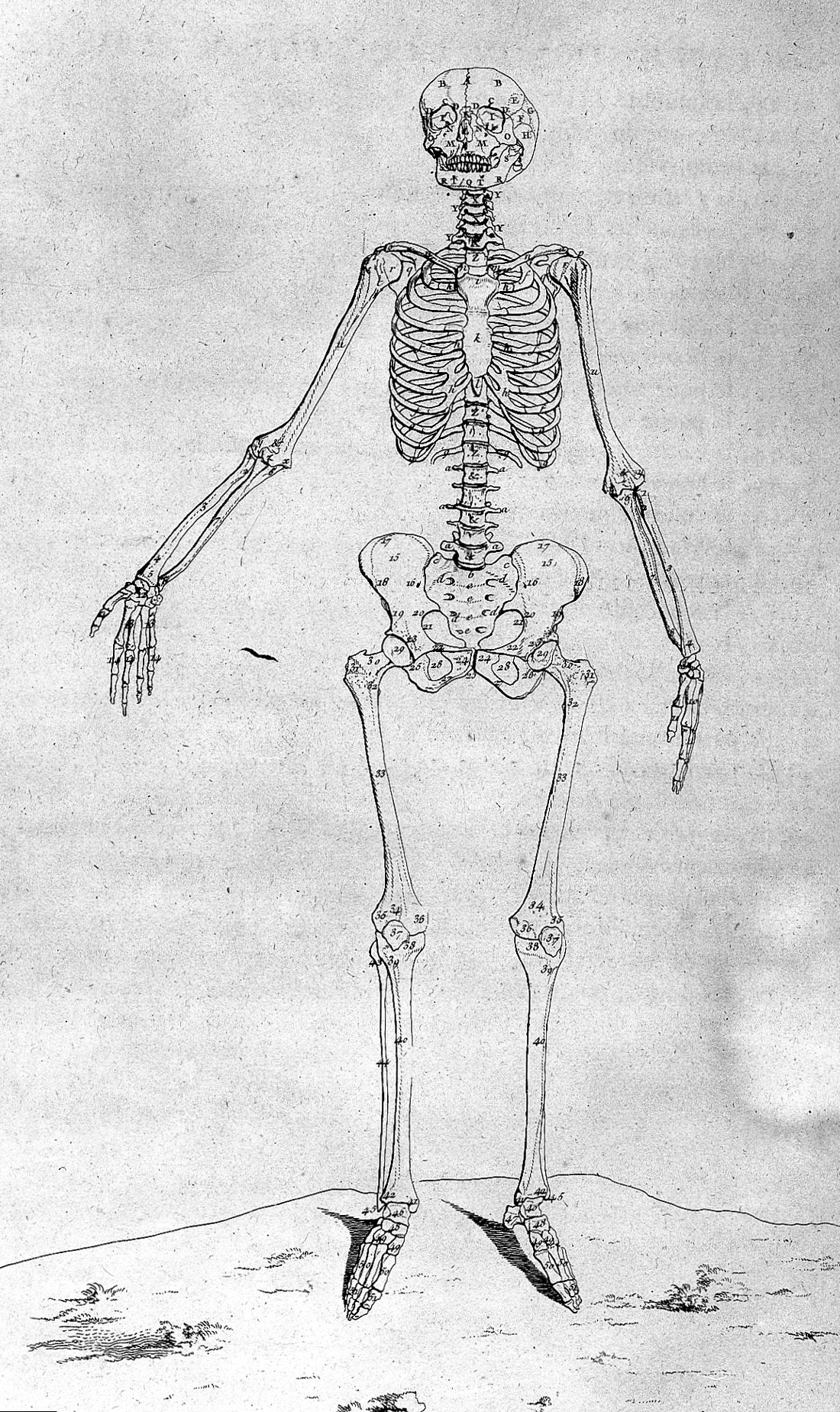
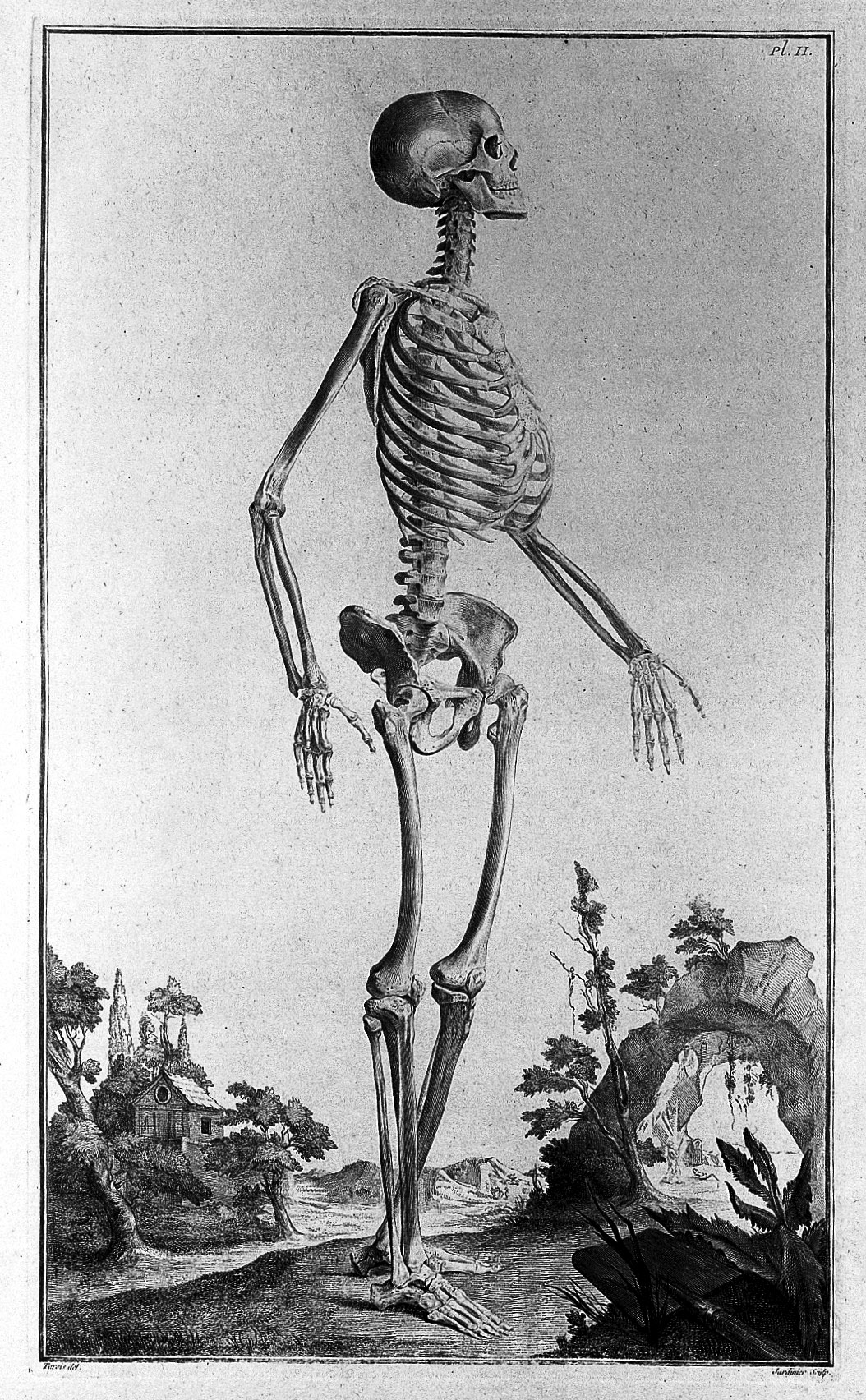
Later, in the nineteenth century, the gender question was addressed through the then-popular pseudoscience of phrenology: the examination of skull features that allegedly reveal mental qualities and character. Such analyses pointed to women’s “low foreheads” as proof that they lacked the necessary cognitive abilities for participation in intellectual pursuits (Staum 2003, 64). We now explain differences in male and female skull size as due to sexual dimorphism: since male bodies are (on average) slightly larger than female bodies, their skulls must be proportionate to the rest of their bodies. Further, there is no proven correlation between skull size and brain function: skull size does not correlate with intellectual capacity (Gould 1981). Nevertheless, the attempt to scientifically prove men’s worth, like the attempt to theologically prove women’s secondary status, served to affirm a strict binary gender hierarchy. In many parts of the Global North, this hierarchy has had profound social consequences: it justified the disenfranchisement of women in civic life and formal employment and excluded gender minorities from institutions such as marriage and the military.
Gender in the Global North Today
By the end of the twentieth century, most of the claims made by pseudoscience about gender had been corrected. Nevertheless, many of the underlying ideas and assumptions it produced persisted, including those that justified inequality for women and gender minorities. For instance, by the year 2000, women in the United States on average earned seventy-one cents per every dollar that a man earned (Graf et al. 2019). By 2020, that rate rose to eighty-five cents, although, paradoxically, women for the first time also made up more than half the workforce (Omeokwe 2020). Transgendered people in many parts of the Global North face discrimination, violence, anemic legal protections and obstacles accessing health care, among other concerns. While we explore some of these contemporary gender-related issues in the Global North, we also recognize that gender is dynamic and responsive to larger social, cultural, and political forces.
Gender and Sexual Violence
The Global North in the twentieth century is marked by a gradual arc of increasing gender equity; however, some countries, and particular groups within these countries, continue to experience high rates of gender-based violence. In the United States, Canada, and Australia, for example, ethnic minorities and Indigenous women tend to experience the highest rates of such violence. The concept of intersectionality allows us to understand the compounding factors of oppression (such as poverty, racism, sexism, social neglect, among others) that contribute to gender violence within some communities in the Global North. For instance, in the United States, murder is the third top cause of death for American Indian women, which is more than twice the rate than for white women (Heron 2018). In Canada, Indigenous women are sixteen times more likely than white women to be murdered or go missing (National Inquiry into Missing and Murdered Indigenous Women and Girls 2019). And in Australia, aboriginal women are thirty-two times more likely to be hospitalized as a result of domestic violence and ten times more likely to die from a violent assault than non-Indigenous women (Australian Institute of Health and Welfare 2018).

Sexual violence continues to plague the Global North, despite some progress overall. These issues received increased attention in the late 2010s. Most notably, the #MeToo movement gained international traction when a series of actresses and celebrities came forward accusing Harvey Weinstein, a US film producer, of rape and sexual assault. The Twitter hashtag #MeToo exploded after actress Alyssa Milano used it in a tweet to highlight her connection to other survivors of sexual assault. Hundreds of thousands of women joined in by disclosing that they, too, had been sexually assaulted or abused. The movement was later criticized for ignoring the origin of the phrase, which was coined by activist Tarana Burke in 2006. Many claimed that Burke’s work to bring awareness to the frequency of sexual assault had been overlooked because as an African American woman her voice was not heard or respected as much as white women’s or celebrities’ voices.
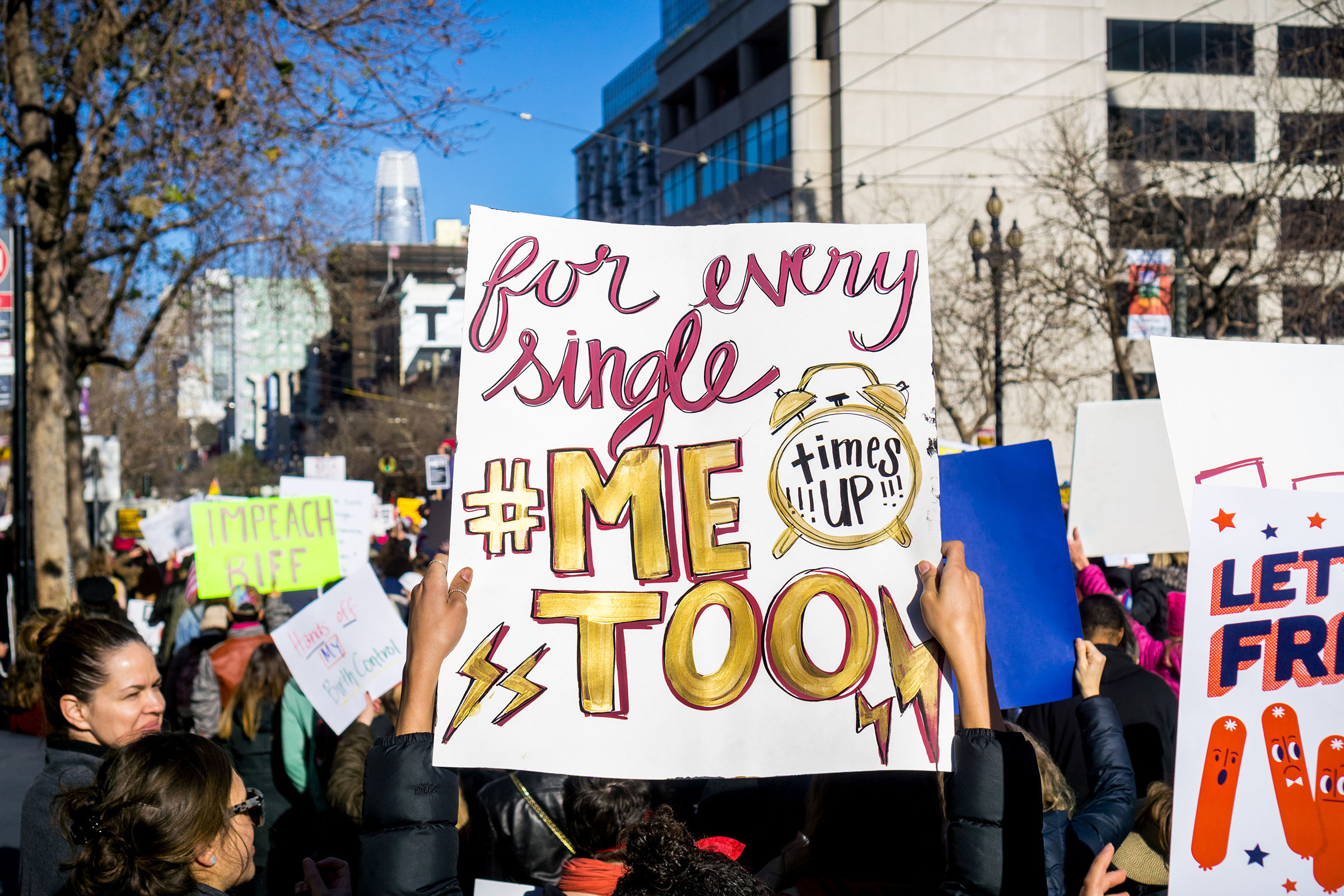
In the United States the #MeToo movement is credited with helping center sexual assault within the national narrative. Nevertheless, US society, like other societies, still struggles with how to talk about and address this problem. Further, awareness of sexual assault within other gendered populations (such as the transgender community) receives even less attention.
Transgender and Gender Nonconforming Identities
Similar to the increasing awareness and sensitivity to sexual assault, societal awareness of the lived experiences of transgender and gender-diverse people has improved in recent years. Transgendered people are those whose biological sex at birth is inconsistent with their gender identity. In addition, some Northern societies are increasingly recognizing people who do not identify as male or female, or whose gender identity is fluid. Languages are adapting to these changes by including new pronouns, verbs, and nouns. For instance, some English-speaking populations are using “they/them” or “xe/xem” instead of “he/she.” In Spanish, words ending with “a” are usually considered feminine, and those ending with “o” are usually considered masculine. However, some Spanish-speaking populations are now using the gender-neutral “x” in place of “a” or “o” at the end of words, as in “Latinx.”
Gender-diverse people are increasingly visible in popular television programs and movies, and some countries have established policies to protect their rights. For instance, in 2014, the Danish parliament passed legislation that allows legal gender recognition for transgender people based solely on their self-determined identity (Transgender Europe 2014). In 2016, a similar law was passed in Norway. However, many countries in Europe do not have such policies or protections, or they require a psychiatric or medical diagnosis for a legal gender change (Transgender Europe 2016). This is compounded by societal stigma and lack of public understanding, which results in widespread discrimination and marginalization of transgender people. For instance, in the United States, 29 percent of transgender people surveyed live in poverty, and 30 percent had been homeless at some point in their lives (according to a 2015 survey conducted by National Center for Transgender Equality). Their unemployment rate was 15 percent—three times the national average (National Center for Transgender Equality 2016). Transgender people are also more likely to avoid seeking medical care because they experience discrimination, disrespect, and even harassment in health-care settings.
In addition, transgender and gender nonconforming people have faced discrimination in bathroom use, particularly in the United States. For instance, 16 American states have considered legislation that would restrict access to multiuser bathrooms (and other sex-segregated facilities) on the basis of one’s sex assigned at birth (Kralik 2019). Although most of these efforts failed or were withdrawn, the issue still remains highly contentious. As anthropologist Robert Myers stated, “Americans match deep convictions about males and females with binary spaces to perform those necessary biological functions. . . . the bathroom is the central space where beliefs and anxieties about gender, the body, identity, privacy and safety collide. It is a culture war waged over symbolic spaces reinforcing constructions of how we see ourselves privately and publicly” (Myers 2018). While bathrooms remain politically charged gendered spaces, people are becoming aware of gender diversity in ways that are starting to rattle their prior convictions. Many colleges and universities, and a variety of public and private institutions, are designating gender-neutral bathrooms that are available for anyone to use, regardless of their gender identity or expression.
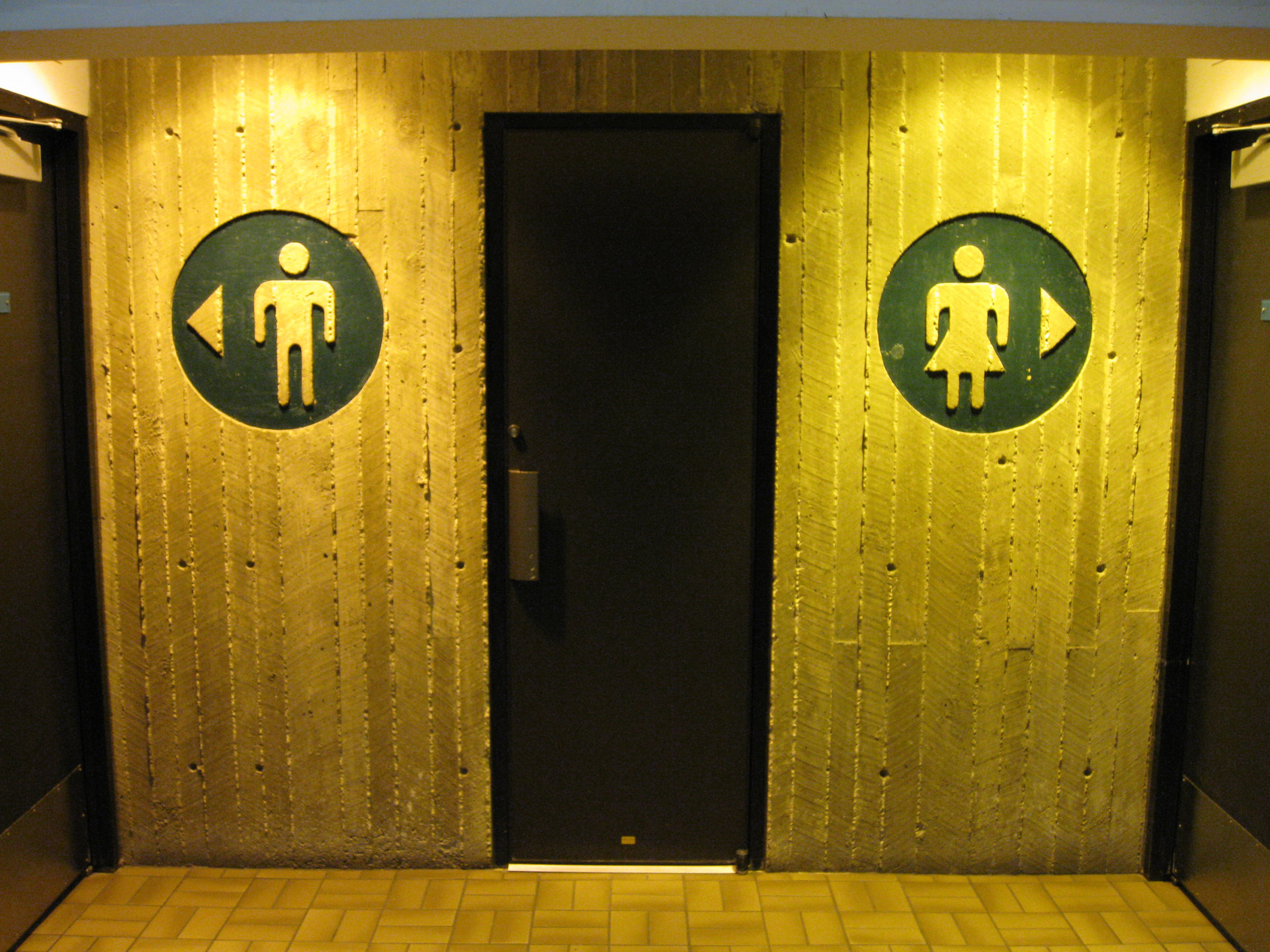
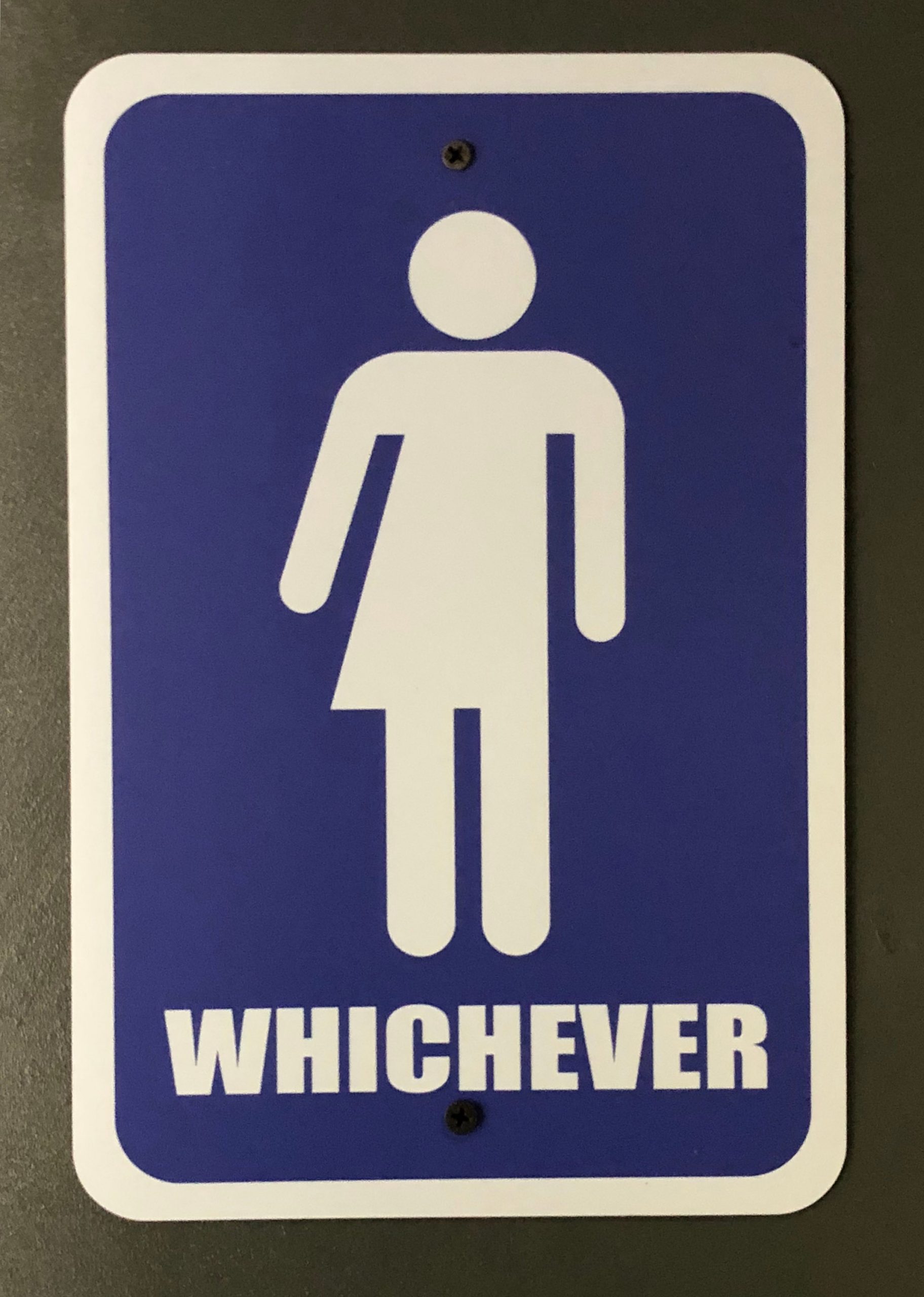
Patriarchy
The problems of restrictions on transgender people’s bathroom use, sexual assault, and sexual violence are tied to a lingering system of patriarchy that remains deeply embedded in societies in the Global North. Patriarchy has long been a central structural element of many societies and is characterized by a set of culturally specific symbols, behaviors, and ideas that are male dominated, male identified, and male-centric. This structure normalizes a worldview of binary gender, gender stereotypes, and the limitation of gender roles, among other things. Patriarchy reaches deep into the fabric of societies, which makes its existence difficult to see but profoundly influential. For instance, in the Global North, patriarchy influences inflexible notions of what it means to be “feminine” and “masculine.” These notions are seen in the expectations for cisgender men to serve in the military and for women to be more responsible for domestic work. They are also seen in the paucity of men employed in care services, such as nursing and childcare, and a low number of women in manual labor-intensive work like construction or in political leadership positions.
Consider another example. You may have heard a popular riddle that goes something like this: “A father and son have a car accident and are both badly hurt. They are both taken to separate hospitals. When the boy is taken in for an operation, the surgeon says, ‘I cannot do the surgery because this is my son.’ How is this possible?” The trick (spoiler alert!) is that the surgeon is, of course, the boy’s mother. This riddle is perplexing to many people who have been socialized to associate being a surgeon with being a man. The possibility that a woman (or mother) might be the surgeon seems so unlikely that we unconsciously do not even consider it. These types of associations are embedded within a patriarchal order that influences how people in the Global North see the world and their place in it.
Another manifestation of patriarchy can be seen in hypermasculine gender expressions, sometimes referred to as toxic masculinity. In the Global North, this form of masculinity tends to be characterized by qualities such as a competitive nature, physical strength, emotional suppression, rejection of femininity, risk taking, and violence. In January 2019 the American Psychological Association released a set of new guidelines for psychologists who work with males. The guidelines suggested that being enculturated into a traditional masculine ideology does harm not only to women and people with nonconforming gender identities but also to boys and men. The guidelines highlighted the impact of toxic masculinity on boys and men, which includes poor mental and physical health outcomes (American Psychological Association 2018). For example, toxic masculinity deems anger as the only appropriate emotion men can express, which can lead to the distancing of men from others, resulting in difficulty developing and sustaining close relationships. Further, since toxic masculinity dictates that men should be strong and independent, some men feel they cannot seek help from others for their mental or physical issues.
Despite the influence of patriarchy, many of these gendered characteristics have been changing in recent years. More men and women are entering into nontraditional gender employment, and more women are taking on leadership roles. Men are increasingly active in childrearing, and some are even opting to stay home and raise children while their spouse works outside the home. Gender, and the influence of patriarchy, is in flux in the Global North.
Conclusion
Just as the Global North/South divide was developed to give order to an increasingly complex interrelated world system, the male/female divide, as rendered in the Global North, was developed to make sense of different yet interrelated sexed bodies. These bodies came to be understood in binary and hierarchical terms: one was either male or female, with male privileged over female. While in other places, males, females, and other genders had been understood in distinctive ways, the value-laden gender hierarchy of the Global North was disseminated widely due to the region’s social, economic, and political power. To denaturalize these value-laden divisions—North/South, male/female—we must see them for what they are: social-historical constructs that are tied to power and carry real consequences for the lives of men, women, and sexual minority communities. And yet gender is dynamic: as we have discussed, gender roles are in flux, women are asserting their rights, members of sexual minority groups are being heard, and masculine ideals are being challenged.
The chapters in Part V: The Global North present anthropological research that showcases some of the gendered experiences of men and women from different places in the social hierarchy in highly unequal and stratified regions. Chapter 16 examines mothers in upper-middle–class households in a large northeast city. In online forums these women compete to perform “proper” motherhood. Their online performances serve as practice for how they will interact with their peers as ideal mothers in real life. Male sex workers are the focus of chapter 17. Here we see how gendered stereotypes of sex workers blind legislators and social service agencies to the violence and vulnerability of young men in the sex trade. In this case, an intersectional approach reveals the subordination and structural violence these men experience. Chapters 18 and 19 explore the gendered lives of migrants living in the Global North. Muslim women in Belgium respond to discrimination and reclaim their agency and resist marginalization. Chapter 19 shows how undocumented migrants from Mexico struggle to redefine their roles as fathers when children are left behind in the home village or parents are deported to Mexico leaving children behind in the United States. In these transnational families, fathers must negotiate different norms and expectations of parenthood on both sides of the border. Finally, the profile at the end of this introduction highlights the work of Kathleen Steinhauer, who fought for the rights and recognition of Indigenous women in Canada.
Key Terms
cisgender: refers to people whose gender identity corresponds to their sex at birth.
Global North: does not refer to a geographic region in any traditional sense but rather to the relative power and wealth of countries in distinct parts of the world. The Global North encompasses the rich and powerful regions such as North America, Europe, and Australia.
globalization: the worldwide intensification of social and economic interactions and interdependence between disparate parts of the world.
glocalization: a combination of the words “globalization” and “localization.” Refers to ways that a cultural product is developed by one culture and adopted by the local culture to accommodate local needs and preferences.
hegemony: the dominance of one group over another supported by legitimating norms and ideas that normalize dominance. Using collective consent rather than force, dominant social groups maintain power and social inequalities are naturalized.
intersectionality: refers to the interconnected nature of social categories such as race, class, and
gender that creates overlapping systems of discrimination or disadvantage. The goal of an intersectional analysis is to understand how racism, sexism, and homophobia (for example) interact together to impact our identities and how we live in our society.
misogynous/misogyny: refers to the contempt or hatred for women, often expressed as prejudice or discrimination.
patriarchy: a dynamic system of power and inequality that privileges men and boys over women and girls in social interactions and institutions. Patriarchy describes a society with a male-dominated political and authority structure and an ideology that privileges males over females in domestic and public spheres.
toxic masculinity: tends to be characterized by qualities such as a competitive nature, physical strength, emotional suppression, rejection of femininity, risk taking, and violence.
world systems theory: Developed by Emmanuel Wallerstein to describe a global capitalist system that separates countries into the core (the North), semiperiphery, and periphery (the South) based primarily on their economic participation.
Bibliography
American Psychological Association. 2018. APA Guidelines for Psychological Practice with Boys and Men. Washington, DC: American Psychological Association.
Appadurai, Arjun. 1996. Modernity at Large: Cultural Dimensions of Globalization. Minneapolis: University of Minnesota Press.
Aristotle. 1905. Aristotle’s Politics. Oxford: Clarendon.
Australian Institute of Health and Welfare. 2018. Family, Domestic and Sexual Violence in Australia, 2018. Canberra: Australian Institute of Health and Welfare.
Biewen, John. “Skeleton War.” MEN. Scene on Radio, August 8, 2018. http://www.sceneonradio.org/tag/season-3.
Gould, Stephen Jay. 1981. The Mismeasure of Man. New York: W.W. Norton.
Graf, Nikki, Anna Brown, and Eileen Patten. 2019. “The Narrowing, but Persistent, Gender Gap in Pay.” Fact Tank. Washington, DC: Pew Research Center.
Heron, Melonie. 2018. Deaths: Leading Causes for 2016. National Vital Statistics Reports 67, no. 6. Hyattsville, MD: National Center for Health Statistics.
Kralik, Joellen. 2019. “‘Bathroom Bill’ Legislative Tracking.” Washington, DC: National Conference of State Legislatures.
Myers, Robert. 2018. “That Most Dangerous, Sacred American Space, the Bathroom.” 10, no. 1 Anthropology Now.
National Inquiry into Missing and Murdered Indigenous Women and Girls. 2019. Reclaiming Power and Place: The Final Report of the National Inquiry into Missing and Murdered Indigenous Women and Girls, Volume 1a. National Inquiry, Canadian Government.
National Center for Transgender Equality. 2016. The Report of the 2015 U.S. Transgender Survey. Washington, DC: National Center for Transgender Equality.
Omeokwe, Amara. 2020. “Women Overtake Men as Majority of U.S. Workforce.” Washington Post. January 10, 2020.
Staum, Martin. 2003. Labeling People: French Scholars on Society, Race and Empire, 1815–1848. Montreal: McGill-Queen’s University Press.
Transgender Europe. 2014. “Denmark Goes Argentina!” June 11, 2014. https://tgeu.org/denmark-goes-argentina/.
Transgender Europe. 2016. “34 Countries in Europe Make this Nightmare a Reality.” February 23, 2015. https://tgeu.org/nightmare/.
Wallerstein, Immanuel. 1974. The Modern World-System: Capitalist Agriculture and the Origins of the European World-Economy in the Sixteenth Century. Studies in Social Discontinuity. New York: Academic Press.
does not refer to a geographic region in any traditional sense but rather to the relative power and wealth of countries in distinct parts of the world. The Global North encompasses the rich and powerful regions such as North America, Europe, and Australia.
Developed by Emmanuel Wallerstein to describe a global capitalist system that separates countries into the core (the North), semiperiphery, and periphery (the South) based primarily on their economic participation.
a combination of the words “globalization” and “localization.” Refers to ways that a cultural product is developed by one culture and adopted by the local culture to accommodate local needs and preferences.
the worldwide intensification of social and economic interactions and interdependence between disparate parts of the world.
the dominance of one group over another supported by legitimating norms and ideas that normalize dominance. Using collective consent rather than force, dominant social groups maintain power and social inequalities are naturalized.
refers to individuals who identify with the sex and gender assigned to them at birth.
refers to the contempt or hatred for women, often expressed as prejudice or discrimination.
refers to the interconnected nature of social categories such as race, class, and gender that create overlapping systems of discrimination or disadvantage. The goal of an intersectional analysis is to understand how racism, sexism, and homophobia (for example) interact together to impact our identities and how we live in our society.
Patriarchy describes a society with a male-dominated political and authority structure and an ideology that privileges males over females in domestic and public spheres.
tends to be characterized by qualities such as a competitive nature, physical strength, emotional suppression, rejection of femininity, risk taking, and violence.

